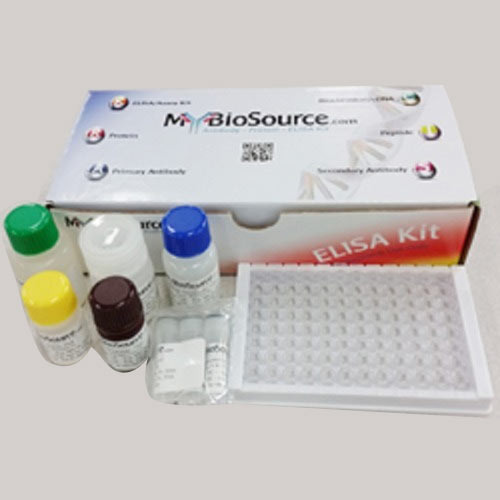MyBioSource Human Neurofilament (NF) ELISA Kit
Catalog No :
CAS Number :
Brand :
In Stock
Specifications:
| Application | ELISA-Based Assays |
| Storage Temperature | 2-8°C |
| Product Type | Elisa Kit |
| Product Brand | MyBioSource |
| Product Grade | Molecular Biology |
The Neurofilament (NF) ELISA Kit is a highly sensitive and specific tool designed for the quantitative detection of neurofilament protein (NF) in human biological samples, including serum, plasma, and cell culture supernatants. Using a sandwich ELISA technique, this kit is ideal for researchers studying neuronal integrity, neurodegeneration, and related conditions.
Key Features:
- High Sensitivity and Precision:
- Detection range: 0.312–20 ng/mL.
- Sensitivity: Up to 0.06 ng/mL.
- Intra-assay precision: ≤ 8%.
- Inter-assay precision: ≤ 12%.
- Quantitative Sandwich ELISA:
- Employs a monoclonal antibody as the pre-coated capture antibody and a biotinylated polyclonal antibody for detection.
- Colorimetric detection using TMB substrate ensures accurate and reliable quantification.
- Broad Sample Compatibility:
- Validated for use with human serum, plasma, and cell culture supernatants.
- Ease of Use:
- Ready-to-use microwell strip plate format simplifies sample preparation and processing.
- ISO-Certified Manufacturing:
- Produced in an ISO 9001:2015 Certified Laboratory, ensuring consistent quality and reliability.
Specifications:
| Feature | Details |
|---|---|
| Assay Type | Quantitative Sandwich ELISA |
| Detection Range | 0.312–20 ng/mL |
| Sensitivity | 0.06 ng/mL |
| Intra-Assay Precision | ≤ 8% |
| Inter-Assay Precision | ≤ 12% |
| Sample Types | Human serum, plasma, cell culture supernatants |
| Target Molecule | Neurofilament (NF) |
| Molecular Weight of NF | 61,517 Da |
| Storage Conditions | 2–8°C |
Applications:
- Neurodegenerative Disease Research:
- Detects and quantifies neurofilament levels in studies of conditions like Alzheimer's, Parkinson's, and multiple sclerosis.
- Biomarker Studies:
- Evaluates neurofilament as a biomarker for axonal damage and neuronal health.
- Neurotoxicity Assessments:
- Monitors the effects of neurotoxic compounds or treatments on neuronal structures.
- Basic Neuroscience Research:
- Investigates the role of neurofilament proteins in neuronal function and pathology.
Principle of the Assay:
- Capture and Detection:
- A monoclonal anti-human NF antibody is pre-coated onto the ELISA plate.
- Biotinylated polyclonal antibodies are used as detection antibodies to bind the target NF antigen.
- Enzymatic Reaction:
- After washing steps, avidin-peroxidase conjugates are added, followed by TMB substrate, which reacts to form a color.
- Quantification:
- The color intensity correlates with the NF concentration, and the signal is measured at a specific wavelength after adding stop solution.
Advantages:
- High Sensitivity:
- Detects low levels of NF in a wide range of samples, enabling early detection and quantification.
- Reproducibility:
- Ensures consistent and reliable results with low intra- and inter-assay variability.
- Flexible Sample Input:
- Compatible with multiple human biological sample types for diverse applications.
- User-Friendly Protocol:
- Simplifies experimental workflows with a ready-to-use strip plate format and detailed instructions.
Preparation and Storage:
- Storage: Store all reagents at 2–8°C. Avoid freezing.
- Reagent Handling: Briefly centrifuge vials before opening to ensure the contents are fully collected.
Ordering Information:
| Catalog Number | Description | Unit Size |
|---|---|---|
| MBS264177 | Human Neurofilament (NF) ELISA Kit | Full kit for 96 wells |
Notes:
- Dynamic Research Tool:
- ELISA kits may undergo updates for improved performance. Refer to the included manual for the most accurate and current protocol.
- Handling Precautions:
- If small volumes are trapped in the seal, centrifuge briefly to recover all liquid.
- Non-Diagnostic Use:
- This kit is intended for research use only and not for diagnostic procedures.
The Neurofilament (NF) ELISA Kit is a reliable and sensitive tool for detecting and quantifying neurofilament proteins in human samples. With its broad application scope, high reproducibility, and ease of use, it is an essential addition to neuroscience and biomarker research laboratories.




 0
0
